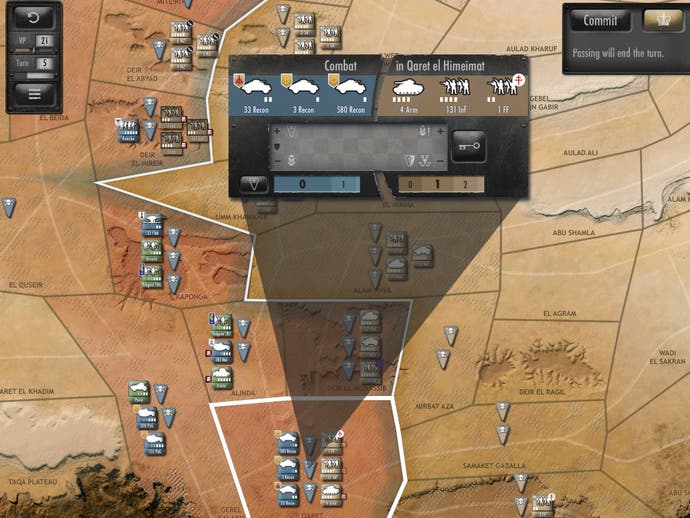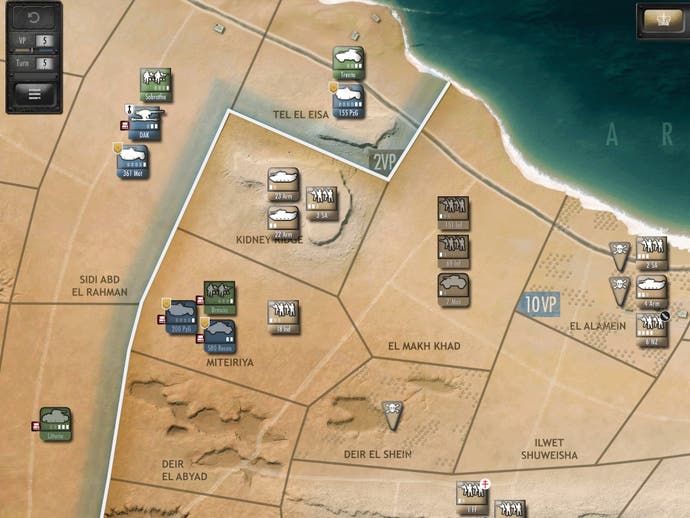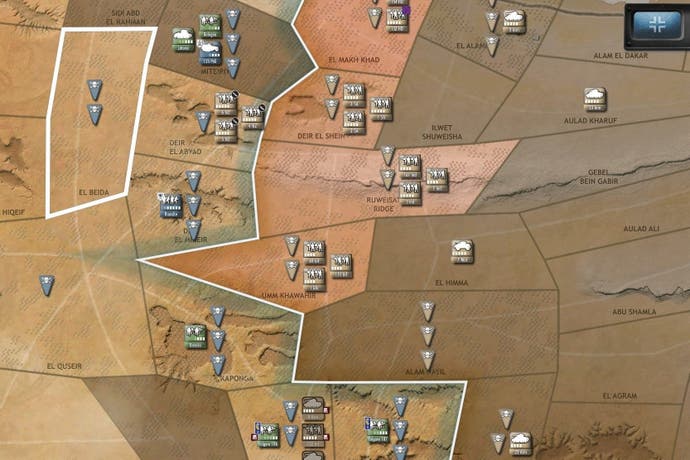Desert Fox: The Battle of El Alamein review
Granular.
I perform a sort of dance in the desert, careful where I tread. It's a slow dance, in part because there are mines scattered about - so many mines - but also because any misstep I make could offer a dangerous opportunity, could present a sudden vulnerability. The partner I dance opposite is ready to pounce and I never quite know whether to feint, to pause, or whether it's finally, finally the moment where I should make my move.
Desert Fox: The Battle of El Alamein is all about movement and positioning. Well, it's almost all about movement and positioning. A not insignificant part of it is also about supplies, about whether you and your army are going to have dinner tonight, but even that really depends upon positioning. As was the case with the real North African campaign of the early 1940s, the great dance across the deserts of Egypt is a shuffle back and forth across this tremendous expanse and encirclement, entrenchment and brave, bold excursions are as important as any pitched battles.
Following on from Drive on Moscow and Battle of the Bulge (much beloved by strategy fan Rich Stanton), Desert Fox: The Battle of El Alamein uses many of the same concepts and mechanics, now proven on the field of battle and not found to be lacking. Wargames, particularly the sort that make little attempt to hide a hex-based heritage that's all cardboard counters and monotonous manuals, don't have to be complicated and they don't have to alienate more casual players. Once again, Desert Fox: The Battle of El Alamein takes a gentler approach and, like all things gentle, still manages to be a nuanced and quite subtle experience: everything is easy to do, but there's always a lot to consider.

First of all, there's the turn mechanic where each side activates one region of the map at a time, moving all the units in it and resolving any fights they start. Time then ticks by, but at an unpredictable rate, and then the opposing general makes their move, activating another, single section of the map and pushing the clock further. There are only so many hours in a day, so no guarantee either side might have enough time to issue all the orders they want to. Prioritising is critical and the chance to conduct pre-dawn raids, an opportunity that belongs to the side holding the initiative, can be as effective as it is exclusive. Either side can elect to pass on their next move, a sort of feint that forces their rival to act again, but this can backfire. If both parties pass in turn, the day is done, no matter how many hours are left.
Then there's the value in movement. Counters representing infantry, armour and flak batteries are carefully nudged across the map, moved with the understanding that lines of supply are crucial. Troops that can trace lines of supply back to their side of the map will always fight more effectively, while those cut off from their boil-in-the-bag rations will, given time, wilt in the desert sun. Egypt is not a featureless country and the ridges that give contour to its land quickly become the focus points for battles or the axes around which armies pivot. Some terrain is a terror for tanks, which otherwise gallop down almost labyrinthine roads, while infantry units practically burrow their way into hard cover.
This is why surrounding or cutting off stubborn pockets of resistance becomes vital, as well as why an unsupervised reconnaissance unit can be a knife to the jugular of your strategy. Well-timed thrusts through the lines can disrupt supplies and hungry units are found wanting. It doesn't take long to learn that holding safe ground is often so much wiser than surging into battle, while watching a frustrated opponent try to dislodge you from your carefully-prepared positions is both satisfying and amusing.

There's quite a lot going on behind the scenes, with each battle considering the experience of its participants, the terrain, their supply status, the mixture of units fighting and much more, but the possible outcomes are always presented clearly beforehand. Below each army, a bar is divided up into sections that represent outcomes according to how likely they are. A large section with a bold number "2" suggests two hits will be inflicted, while each side of it there might be smaller sections labelled "1" and "3" that serve as a reminder that battles are somewhat unpredictable. Unexpected victories occur alongside disappointing defeats, but combat is rarely quick. Once engaged, units whittle one other down over several turns and these prolonged battles of attrition are a stagger and a stumble down the slow path to victory. It's important to know when and where to start a fight, as well as when to leave one, in order to find success as soon as you can.
Around all this is a periphery of logistics, menus and scenario outlines that you can tap your way through to find briefings that come with typed summaries and scribbled notes, dog-eared orders or torn calendars that dutifully note the dates of reinforcements and resupplies. The game is proudly polished and presents the same sort of attention to detail that it expects from its generals, which is why it sometimes surprises with the occasional absurd move from the AI.
Don't get me wrong, Desert Fox: The Battle of El Alamein is a hard game and it punishes you for being hasty, being ignorant or being plain bad, but it will occasionally send its units on suicide missions for no appreciable gain, or overreach in ways that might make you feel embarrassed by its impulsiveness. These moments are rare and, I suppose, can be excused as examples of any general's fallibility, but when they happen they're so stark against the methodical approach it usually presents that they baffle outright. Most of the time, the AI is a serious challenge and it's very easy to start to take losses quite personally, so intelligently does it usually respond. That spearhead is an outright intrusion. That well-timed tank attack is an act of arrogance. That obstinate pocket of resistance stands out like a pus-filled pimple against the otherwise uniform colour of your claims. That sort of thing.
So, like its namesake, Desert Fox: The Battle of El Alamein is clever. It's engaging, satisfying and complex in its concepts but pretty simple in its execution. I just wish there was more of it. After a capable and lengthy tutorial, there are three scenarios to fight through as either side, but even the longest of these campaigns will be finished in an evening. That's not to say you'll have won and be done with the game, but the scope of the game is somewhat limited. It's possible to challenge other players online or even play a game locally, but you'll always be facing the same few setups on the same map. It's also only possible to have one game saved at a time, something that almost seems an acknowledgement of the fact that there's not much else you'll ever need to load up.
But what the game lacks in size, it makes up for in polish and poise. It's not entirely correct to say that Desert Fox: The Battle of El Alamein is small but perfectly formed, but it certainly is a very well-executed, intelligent wargame who's biggest failing is only that there isn't more of it.

